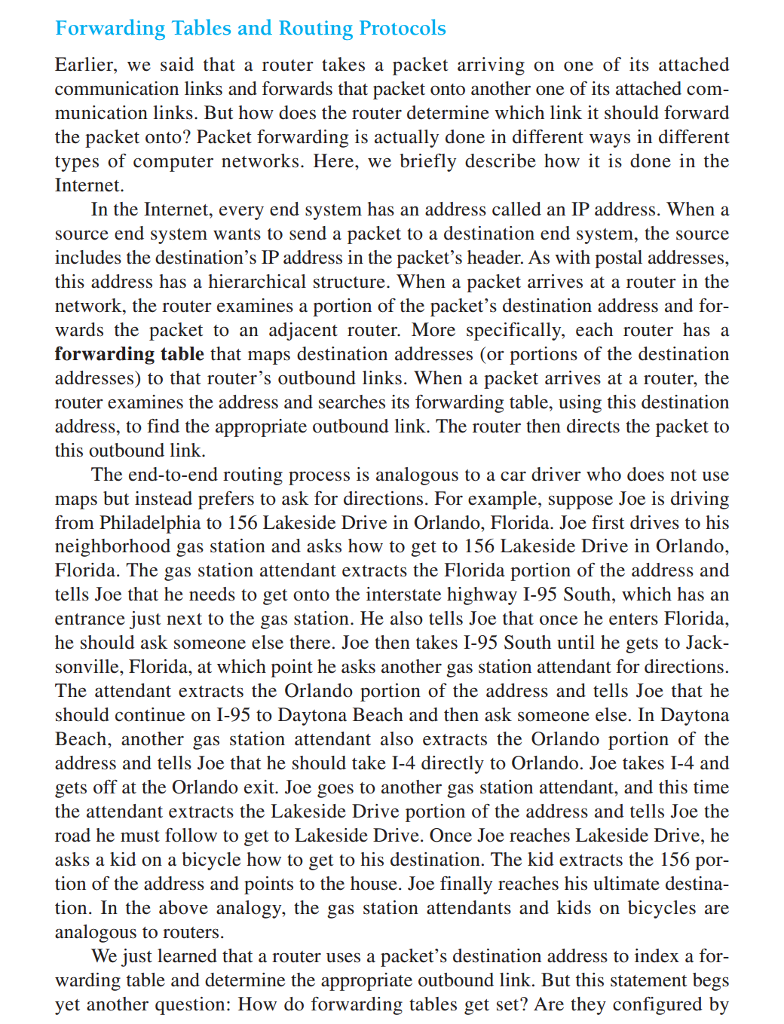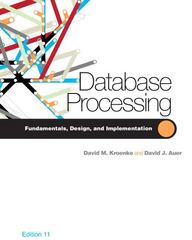P26 from the textbook.
Question isOnce you have the spanning tree, generate the forwarding tables for all routers in the network.

Forwarding Tables and Routing Protocols Earlier, we said that a router takes a packet arriving on one of its attached communication links and forwards that packet onto another one of its attached com munication links. But how does the router determine which link it should forward the packet onto? Packet forwarding is actually done in different ways in different types of computer networks. Here, we briefly describe ho it is done in the Internet In the Internet, every end system has an address called an IP address. When a source end system wants to send a packet to a destination end system, the source includes the destination's IP address in the packet's header. As with postal addresses this address has a hierarchical structure. When a packet arrives at a router in the network, the router examines a portion of the packet's destination address and for wards the packet to an adjacent router. More specifically, each router has a forwarding table that maps destination addresses (or portions of the destination addresses) to that router's outbound links. When a packet arrives at a router, the router examines the address and searches its forwarding table, using this destination address, to find the appropriate outbound link. The router then directs the packet to this outbound link The end-to-end routing process is analogous to a car driver who does not use maps but instead prefers to ask for directions. For example, suppose Joe is driving from Philadelphia to 156 Lakeside Drive in Orlando, Florida. Joe first drives to his neighborhood gas station and asks how to get to 156 Lakeside Drive in Orlando Florida. The gas station attendant extracts the Florida portion of the address and tells Joe that he needs to get onto the interstate highway I-95 South, which has an entrance just next to the gas station. He also tells Joe that once he enters Florida he should ask someone else there. Joe then takes I-95 South until he gets to Jack sonville, Florida, at which point he asks another gas station attendant for directions The attendant extracts the Orlando portion of the address and tells Joe that he should continue on I-95 to Daytona Beach and then ask someone else. In Daytona Beach, another gas station attendant also extracts the Orlando portion of the address and tells Joe that he should take I-4 directly to Orlando. Joe takes I-4 and gets off at the Orlando exit. Joe goes to another gas station attendant, and this time the attendant extracts the Lakeside Drive portion of the address and tells Joe the road he must follow to get to Lakeside Drive. Once Joe reaches Lakeside Drive, he asks a kid on a bicycle how to get to his destination. The kid extracts the 156 por tion of the address and points to the house. Joe finally reaches his ultimate destina tion. In the above analogy, the gas station attendants and kids on bicycles are analogous to routers We just learned that a router uses a packet's destination address to index a for arding table and determine the appropriate outbound link. But this statement begs yet another question: How do forwarding tables get set? Are they configured by Forwarding Tables and Routing Protocols Earlier, we said that a router takes a packet arriving on one of its attached communication links and forwards that packet onto another one of its attached com munication links. But how does the router determine which link it should forward the packet onto? Packet forwarding is actually done in different ways in different types of computer networks. Here, we briefly describe ho it is done in the Internet In the Internet, every end system has an address called an IP address. When a source end system wants to send a packet to a destination end system, the source includes the destination's IP address in the packet's header. As with postal addresses this address has a hierarchical structure. When a packet arrives at a router in the network, the router examines a portion of the packet's destination address and for wards the packet to an adjacent router. More specifically, each router has a forwarding table that maps destination addresses (or portions of the destination addresses) to that router's outbound links. When a packet arrives at a router, the router examines the address and searches its forwarding table, using this destination address, to find the appropriate outbound link. The router then directs the packet to this outbound link The end-to-end routing process is analogous to a car driver who does not use maps but instead prefers to ask for directions. For example, suppose Joe is driving from Philadelphia to 156 Lakeside Drive in Orlando, Florida. Joe first drives to his neighborhood gas station and asks how to get to 156 Lakeside Drive in Orlando Florida. The gas station attendant extracts the Florida portion of the address and tells Joe that he needs to get onto the interstate highway I-95 South, which has an entrance just next to the gas station. He also tells Joe that once he enters Florida he should ask someone else there. Joe then takes I-95 South until he gets to Jack sonville, Florida, at which point he asks another gas station attendant for directions The attendant extracts the Orlando portion of the address and tells Joe that he should continue on I-95 to Daytona Beach and then ask someone else. In Daytona Beach, another gas station attendant also extracts the Orlando portion of the address and tells Joe that he should take I-4 directly to Orlando. Joe takes I-4 and gets off at the Orlando exit. Joe goes to another gas station attendant, and this time the attendant extracts the Lakeside Drive portion of the address and tells Joe the road he must follow to get to Lakeside Drive. Once Joe reaches Lakeside Drive, he asks a kid on a bicycle how to get to his destination. The kid extracts the 156 por tion of the address and points to the house. Joe finally reaches his ultimate destina tion. In the above analogy, the gas station attendants and kids on bicycles are analogous to routers We just learned that a router uses a packet's destination address to index a for arding table and determine the appropriate outbound link. But this statement begs yet another question: How do forwarding tables get set? Are they configured by







